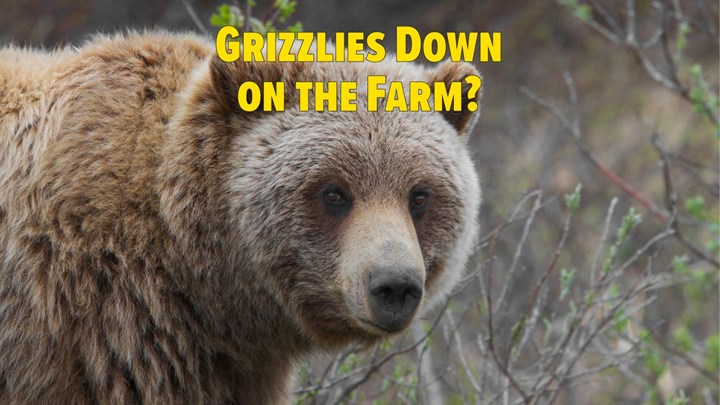
by Phil Phillips - Sunday, June 2, 2019

Fittingly, news reports over Memorial Day weekend addressed honoring those who died in service to our country, but even then tales of anti-hunters slipped into the mix. This time reports covered their ongoing efforts to prevent a grizzly bear hunting season in the Rocky Mountain West despite that bear numbers are thriving and the risk of human-bear encounters is on the rise. On May 25, Fox News reported that wildlife officials in the Greater Yellowstone Ecosystem (GYE)—Wyoming, Montana and Idaho—confirmed yet again that the region’s grizzly bear populations are not only expanding their wilderness range but are encroaching on rural areas. Yet animal rights extremist groups, it said, are still at it, working to permanently close grizzly bear hunting seasons in the Lower 48.
The report highlighted new government data citing that GYE grizzlies have expanded their range by 1,500 square miles over just the past two years. They now inhabit nearly 27,000 square miles, a range that has grown 34 percent in the past decade. According to Frank van Manen with the U.S. Geological Survey, who was quoted in the report, this means we can expect to see more bears on private lands where they can encounter humans and attack livestock.
Yet as this website reported on May 18, Chairman of the House Natural Resources Committee Rep. Raul Grijalva (D-Ariz.) has introduced legislation (H.R. 2532: Tribal Heritage and Grizzly Bear Protection Act) to ban grizzly bear hunting in every state except Alaska. The irony is that the wildlife agencies in the three Lower 48 states that have grizzly bear populations say the bear populations in the 22,500-mile GYE have recovered to the point that legal, regulated hunting is now a necessary wildlife management tool and that in some cases the bears exceed the carrying capacity, or the habitat's ability to support a healthy population. Run-ins with bears are happening in agricultural areas where the bears had not been seen for decades, naturally raising tension levels in local communities over the grizzly's status as a federally-protected species. Tracking the issue since the website launched in 2016, NRAHLF.org continues to note that this is precisely why the U.S. Fish and Wildlife Service proposed removing grizzly bears from Endangered Species Act protections in the first place.
For some history on the issue, in 1975 only an estimated 1,000 grizzlies existed in the wild, prompting the introduction of 136 Yellowstone bears to Wyoming, Idaho and Montana. As of 2016, they totaled more than 700—a number once thought impossible—and now are so densely populated in the GYE that they have expanded their wilderness range and in some areas are bordering rural farm/ranch lands. USFWS’ first attempt at delisting the recovered species was in 2007. Anti-hunting extremist groups mobilized, sued the federal government and got the bear re-listed to keep its management under federal government control. When the USFWS gave its proposed removal another go in 2016, instead of celebrating the species’ recovery—which at that point marked a 41-year conservation success story spearheaded in part by hunters—the antis dug in their heels yet again.
It is not an accident that state wildlife agencies are trying to establish a bear hunt in these areas. As grizzly bear populations meet or exceed carrying capacity, the bears are moving farther and farther out of their historic range. Yet anti-hunters are fighting to keep the hunting season in the GYE closed, hoping to make the population even more “stable,” as reported by Fox News, by letting it merge with the Canadian population. If the extremists can turn a blind eye while people are being mauled and killed by these bears, as covered by this website, the fact that the bears are popping up in ranching communities and causing major problems with livestock predation likely will be met with little concern either. As van Manen noted, "Not all grizzly bears are livestock killers, but of course it only takes a few to potentially do quite a bit of killing." With some ranchers I know in these areas already struggling to address the problems brought on by wolf expansion, now another top-tier predator is consuming their livestock.
Acting on emotion and ignoring issues with predators across the West is yet another example of how misguided animal rights extremists make wildlife management problems worse. This is why wildlife management decisions based on solid scientific facts have always been and always will be the foundation of common-sense wildlife conservation and management.
So How Did We Get Here?
Wyoming and Idaho officials proposed grizzly bear hunts last year to keep the recovered bear populations in check. They were blocked in September 2018 by U.S. District Judge Dana L. Christensen’s ruling to put their efforts on hold, a move that was spurred on and cheered by animal rights extremists. The National Rifle Association, alongside Safari Club International and others, was one of the groups that fought in court for hunters and for the states’ rights to manage their own wildlife. For details on that court decision and the NRA’s efforts to instill common-sense wildlife management based on wildlife science, check out the following links:
For background on the life-and-death issues GYE states are facing due to the lack of recovered grizzly bear management, the following NRAHLF.org articles provide the facts:
E-mail your comments/questions about this site to:
[email protected]
